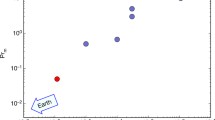Abstract
Modern geodynamo models allow the generation of a magnetic field without reversals and with frequent reversals. The transition from one regime to another is associated with a relatively small change in the intensity of the generation sources. From this, it is usually concluded that the geodynamo system is located near such a transition, which, generally speaking, requires a more detailed justification. Such a transition leads to other changes in the behavior of the geomagnetic field, which are analyzed in this paper based on modern geodynamo models, in particular, the degree to which the dipole of the magnetic field is violated, the change in its strength, and the ratio of the decay time and growth of the dipole during the reversal.


Similar content being viewed by others
REFERENCES
Anufriev, A.P., Reshetnyak, M.Yu., and Hejda, P., Influence of the inner core on the magnetic-field generation in an αω-dynamo model, Geomagn. Aeron. (Engl. Transl.), 1997, vol. 37, no. 1, pp. 111–114.
Christensen, U.R. and Aubert, J., Scaling properties of convection-driven dynamos in rotating spherical shells and application to planetary magnetic fields, Geophys. J. Int., 2006, vol. 166, pp. 97–114. https://doi.org/10.1111/j.1365-246x.2006.03009.x
Christensen, U., Olson, P., and Glatzmaier, G.A., Numerical modelling of the geodynamo: A systematic parameter study, Geophys. J. Int., 1999, vol. 138, no. 2, pp. 393–409. https://doi.org/10.1046/j.1365-246x.1999.00886.x
Gastine, T. and Wicht, J., Effects of compressibility on driving zonal flow in gas giants, Icarus, 2012, vol. 219, no. 1, pp. 428–442. https://doi.org/10.1016/j.icarus.2012.03.018
Glatzmaier, G.A. and Roberts, P.H., A three-dimension self-consistent computer simulation of a geomagnetic field reversal, Nature, 1995, vol. 377, pp. 203–209.
Glatzmaier, G.A., Coe, R.S., Hongre, L., and Roberts, P.H., The role of the Earth’s mantle in controlling the frequency of geomagnetic reversal, Nature, vol. 401, pp. 885–890. https://doi.org/10.1038/44776
Hoyng, P., Helicity fluctuations in mean field theory: An explanation for the variability of the solar cycle?, Astron. Astrophys., 1993, vol. 272, pp. 321–339.
Johns, C.A., Dynamo models and Taylor’s constraint, in Advances in Solar System Magnetohydrodynamics, Priest, R. and Hood, A.W., Eds., Cambridge: Cambridge Univ. Press, 1991, pp. 25–50.
Kono, M. and Schubert, G., Treatise on Geophysics, Vol. 5: Geomagnetism, Amsterdam: Elsevier, 2009, vol. 5.
Pedlosky, J., Geophysical Fluid Dynamics, New York: Springer-Verlag, 1987. https://doi.org/10.1007/978-1-4612-4650-3
Reshetnyak, M.Yu., Tuning of the mean-field geodynamo model, Izv., Phys. Solid Earth, 2017, vol. 53, no. 4, pp. 581–587. https://doi.org/10.1134/S1069351317030090
Reshetnyak, M.Yu., Collapse and recovery of the magnetic field during reversals, Sol. Syst. Res., 2019a, vol. 53, no. 4, pp. 254–260. https://doi.org/10.1134/S0038094619040087
Reshetnyak, M.Yu., Evolution of the inner core of the Earth: Consequences for geodynamo, Magnetohydrodynamics, 2019b, vol. 55, nos. 1–2, pp. 175–183. https://doi.org/10.22364/mhd.55.1-2.21
Reshetnyak, M.Yu. and Hejda, P., Heat flux modulation in domino dynamo model, Open J. Geol., 2013, vol. 2, pp. 55–59. https://doi.org/10.4236/ojg.2013.32B013
Reshetnyak, M.Yu. and Pavlov, V.E., Evolution of the dipole geomagnetic field. Observations and models, Geomagn. Aeron. (Engl. Transl.), 2016, vol. 56, no. 1, pp. 125–139. https://doi.org/10.1134/S0016793215060122
Valet, J.-P., Meynadier, L., and Guyodo, Y., Geomagnetic dipole strength and reversal rate over the past two million years, Nature, 2005, vol. 435, pp. 802–805. https://doi.org/10.1038/nature03674
Wicht, J., Inner core conductivity in numerical dynamo simulations, Phys. Earth Planet. Int., 2002, vol. 132, pp. 281–302. https://doi.org/10.1016/S0031-9201(02)00078-X
Funding
The study was financially supported by the Russian Science Foundation (project no. 19-47-04110).
Author information
Authors and Affiliations
Corresponding author
APPENDIX
APPENDIX
Let us consider the dynamo equations in a spherical layer \({{r}_{1}} \leqslant r \leqslant {{r}_{0}},\) where (\(r,\theta ,\varphi \)) is a spherical coordinate system, r0 = 1, and ri = 0.35. Entering the following units for speed V, time t, pressure P and magnetic field B, ν/d, d2/ν, ϱν2/d2, and \(\sqrt {2\Omega \varrho \nu \mu } \), where d = r0 – ri is the unit of length, ν is the coefficient of kinematic viscosity, \(\varrho \) is the density of matter, and μ is the magnetic permeability, we write the system of dynamo equations in the form
The dimensionless Prandtl, Ekman, Rayleigh, and magnetic Prandtl numbers are given in the form \({\text{Pr}} = \frac{\nu }{\kappa },\) \({\text{E}} = \frac{\nu }{{2\Omega {{L}^{2}}}},\) \({\text{Ra}} = \frac{{\alpha {{g}_{o}}\delta T{{d}^{3}}}}{{\nu \kappa }}\) and \({\text{Pm}} = \frac{\nu }{\eta },\) where κ is the coefficient of molecular thermal conductivity, α is the coefficient of volumetric expansion, go is the acceleration of gravity, δT is the unit of temperature perturbation T relative to the “diffusion” (nonconvective) temperature distribution \({{T}_{0}} = \frac{{{{r}_{i}}(r - 1)}}{{r({{r}_{i}} - 1)}},\) and η is the coefficient of magnetic diffusion.
System (A.1) is closed by vacuum boundary conditions for the magnetic field at r0, ri and by zero boundary conditions for the velocity field and temperature perturbations. The work uses the pseudo-spectral, MPI-code Magic adapted for the Gentoo operating system. For expansions in 65 Chebyshev polynomials and 128 spherical functions, 16 cores were used on Intel (R) Xeon (R) CPU E5-2640 computers. The used code is an amazing example of how, thanks to the enormous efforts of German scientists (Wicht, 2002; Gastine and Wicht, 2012), the pioneering prototype code developed at Los Alamos by Harry Glatzmaier (Glatzmaier and Roberts, 1995), was made publicly available on GitHub.
Rights and permissions
About this article
Cite this article
Reshetnyak, M.Y. Reversals of the Geomagnetic Field: Constraint on Convection Intensity in the Earth’s Core. Geomagn. Aeron. 61, 266–271 (2021). https://doi.org/10.1134/S0016793221020134
Received:
Revised:
Accepted:
Published:
Issue Date:
DOI: https://doi.org/10.1134/S0016793221020134



